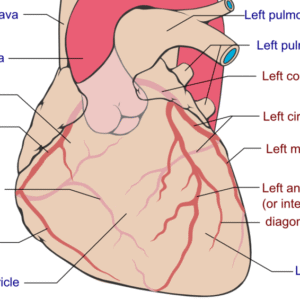Cardiology > Cardiac Tumors
Cardiac Tumors
Background
Cardiac tumors are abnormal tissue growths arising in or around the heart. They are classified as primary (originating in the heart) or secondary (metastatic). Primary cardiac tumors are rare, with most being benign, such as myxomas. Malignant primary tumors like angiosarcomas are less common but highly aggressive. Secondary cardiac tumors are more prevalent and often result from metastases from cancers such as lung, breast, kidney, melanoma, or lymphoma.
II) Classification/Types
By Origin:
- Primary Tumors (Rare):
- Benign: Myxoma, papillary fibroelastoma, lipoma, rhabdomyoma, fibroma
- Malignant: Angiosarcoma, rhabdomyosarcoma, mesothelioma
- Secondary (Metastatic) Tumors (More Common):
- From lung, breast, kidney, melanoma, lymphoma, leukemia
By Location:
- Atrial: Myxomas (most commonly in the left atrium)
- Valvular: Papillary fibroelastomas
- Ventricular wall: Rhabdomyomas, fibromas
- Pericardial: Metastatic tumors, pericardial mesotheliomas
By Tissue Involvement:
- Intracavitary (endocardial)
- Myocardial (intramural)
- Epicardial/pericardial
Pathophysiology
The effects of cardiac tumors depend on size, location, and whether they are infiltrative or obstructive. Benign tumors like myxomas may cause symptoms by obstructing blood flow, embolizing fragments, or producing cytokines (fever, malaise). Malignant tumors tend to infiltrate myocardium or pericardium, causing tamponade, arrhythmias, or heart failure. Secondary tumors often reach the heart via lymphatic spread, direct invasion, or hematogenous routes.
Epidemiology
- Primary cardiac tumors occur in approximately 0.02% of autopsies.
- Around 75% of primary tumors are benign.
- Myxomas account for ~50% of primary tumors in adults.
- Rhabdomyomas are the most common cardiac tumors in children.
- Secondary cardiac tumors are 20–40 times more common than primary tumors.
Etiology
I) Causes
Benign:
- Myxoma: Usually sporadic but can be familial (Carney complex).
- Rhabdomyoma: Associated with tuberous sclerosis.
- Fibroma/Lipoma: Sporadic growths of fibrous or fatty tissue.
Malignant:
- Angiosarcoma: Arises in right atrium; aggressive and hemorrhagic.
- Rhabdomyosarcoma: More common in children.
- Pericardial mesothelioma: Rare; linked to asbestos exposure.
Metastatic tumors:
- Lung and breast carcinoma, melanoma, leukemia, lymphoma, renal cell carcinoma.
II) Risk Factors
- Genetic syndromes (e.g., Carney complex, tuberous sclerosis)
- History of malignancy (for secondary tumors)
- Radiation exposure (associated with pericardial sarcomas)
Clinical Presentation
I) History (Symptoms)
- Dyspnea, orthopnea (from obstruction or tamponade)
- Chest pain, palpitations
- Syncope (if tumor obstructs valves or outflow tracts)
- Systemic symptoms: fever, weight loss, malaise
- Embolic events: stroke, limb ischemia (especially with left atrial myxomas)
II) Physical Exam (Signs)
- Murmurs that change with position (e.g., “tumor plop” in myxomas)
- Signs of right or left heart failure
- Pericardial friction rub or effusion
- Clubbing, rash (in syndromic cases)
Differential Diagnosis (DDx)
- Infective endocarditis (fever + emboli)
- Intracardiac thrombus
- Valvular stenosis or regurgitation
- Cardiac sarcoidosis or amyloidosis
- Constrictive pericarditis
- Atrial septal aneurysm or lipomatous hypertrophy
Diagnostic Tests
Initial Evaluation
- ECG: May show atrial or ventricular arrhythmias
- Chest X-ray: Cardiomegaly, pulmonary edema
- Transthoracic echocardiography (TTE): Initial test of choice
- Transesophageal echocardiography (TEE): Better resolution for posterior or small masses
- Cardiac MRI: Characterizes tissue type, infiltration, vascularity
- CT scan: Defines mass and surrounding structures
- Serology: Rule out infective endocarditis or autoimmune conditions
Specialized Evaluation
- Histopathology: Required for definitive diagnosis (biopsy or surgical specimen)
- Cardiac catheterization: Pre-operative coronary anatomy in surgical candidates
Treatment
I) Acute Management
- Stabilize hemodynamics
- Pericardiocentesis: For tamponade due to tumor-associated effusion
- Anticoagulation: If tumor-associated thrombi or embolism risk
II) Chronic Management
- Surgical Resection: Mainstay for benign tumors (e.g., myxoma)
- Chemotherapy/Radiation: For malignant tumors, especially lymphoma or metastases
- Heart Transplantation: In unresectable benign tumors causing heart failure
- Palliative care: For advanced, non-resectable malignancies
Medications
Drug Class | Examples | Notes |
Anticoagulants | Apixaban, Warfarin | For embolic risk or thrombus |
Diuretics | Furosemide | Symptom relief in heart failure |
Anti-inflammatory | NSAIDs, colchicine | Pericarditis due to tumor |
Chemotherapy agents | Depending on malignancy type | For lymphomas, metastases |
Device Therapy
- Pacemaker/ICD: If tumor causes conduction abnormalities
- Pericardial window or drain: For recurrent malignant pericardial effusions
Patient Education, Screening, Vaccines
- Educate on signs of recurrence or embolic events
- Screen for genetic syndromes in familial tumor cases
- Encourage adherence to follow-up imaging
- Recommend influenza and pneumococcal vaccines in heart failure or immunocompromised patients
Consults/Referrals
- Cardiothoracic Surgeon: For tumor resection
- Oncology: For malignant tumors or metastases
- Genetics: For hereditary tumor syndromes
- Palliative Care: For advanced malignant cases
- Neurology: For embolic stroke workup if applicable
Follow-Up
Short-Term
- Post-operative wound care and imaging
- Monitor for arrhythmia or effusion
- Early echocardiogram for recurrence or residual tumor
Long-Term
- Serial echocardiography (every 6–12 months)
- Surveillance MRI or CT in malignant or incompletely resected tumors
- Monitor for systemic emboli or recurrence
- Continued oncology care for metastatic tumors
Prognosis
- Benign tumors: Excellent prognosis after surgical resection (recurrence <5%)
- Malignant tumors: Poor prognosis with median survival <1 year for sarcomas
- Secondary tumors: Prognosis depends on primary cancer control
- Early detection and intervention improve outcomes, especially in benign cases.
Stay on top of medicine. Get connected. Crush the boards.
HMD is a beacon of medical education, committed to forging a global network of physicians, medical students, and allied healthcare professionals.

